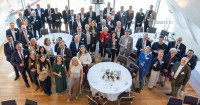Exactly 75 years after its founding in its current form, the LCI's anniversary was celebrated with a scientific colloquium at the Chocolate Museum in Cologne on 1st October 2025. In their welcoming speeches, Chairman Bastian Fassin and representatives of the Federal Institute for Risk Assessment, the Federal Office of Consumer Protection and Food Safety, and the Max Rubner Institute emphasised the uniqueness of this pre-competitive research institution. The industry's commitment is highly valued by the federal authorities and forms the basis for scientific exchange. The technical expertise and neutrality of the LCI ensure that discussions can take place on an equal footing and that the interests of the confectionery industry can be represented in political discourse on a factual basis. Mayor Dr Ralf Heinen conveyed birthday greetings on behalf of the city of Cologne, while the German Food Association was represented by Dr Marcus Girnau. Dr Frank Heckel, Director of the LCI, expressed his gratitude above all to his team and the numerous representatives of the BDSI Presidium present for their constant support of his institute.
In the scientific section, Prof. Dr Hans-Ulrich Humpf from the University of Münster presented the latest findings on furans and their alkyl analogues in breakfast cereals. This group of volatile process contaminants is also relevant for confectionery and snack manufacturers. Prof. Dr Markus Fischer from the Hamburg School of Food Science spoke on the issue of authenticity and food adulteration. He discussed various methods for identifying food fraud, which vary greatly in terms of their significance and cost structure. Finally, Dr Jörg Klinkmann from the scientific committee of the BDSI took a holistic look at the issue of communicative toxicity, which has long since overtaken real health risks in public debate. His birthday present to the LCI was the specially developed ‘Skandalon formula’, which can be used to derive the scandal potential of a chemical compound directly proportional to variables such as chemical sound, NGO volume and error-free writability.


